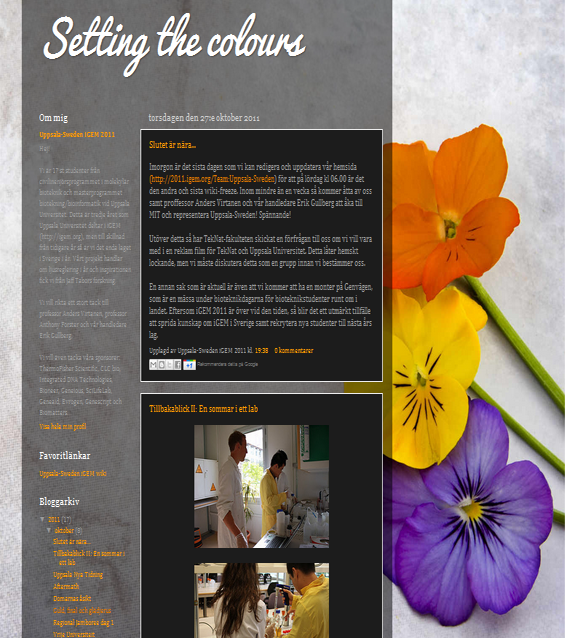Team:Uppsala-Sweden/Biosafety
From 2011.igem.org
iGEM 2011 safety key questions
1. Would the materials used in your project and/or your final product pose:
a. Risks to the safety and health of team members or others in the lab?
- No, neither our material nor our construct produce anything toxic. We use Top10 E. coli as cloning strain, which has very low fitness outside the lab. Our final construct will be in the E. coli strain MG1655. This is a wild type, non pathogenic lab strain, and when we have knocked out one gene and inserted our construct in the bacteria it won’t be competitive outside the lab environment.
b. Risks to the safety and health of the general public if released by design or accident?
- No, we’re not dealing with anything pathogenic and the E. coli strain we’re using is not competitive outside the lab. Our laboratory is located in a locked corridor and only a limited amount of people have access.
c. Risks to environmental quality if released by design or accident?
- No, our construct is not competitive enough to survive outside the lab.
d. Risks to security through malicious misuse by individuals, groups or states?
- The research we’re making is basic research that, as far as we know, doesn’t have any clear application yet. Our project do not use any genes that would give toxicity or increased virulence, so the potential for malicious misuse is low.
Specifically, are any parts or devices in your project associated with (or known to cause):
- pathogenicity, infectivity, or toxicity?
No. The parts used in this project are either well characterized parts from the Registry of Standard Parts or new parts that have been described in peer reviewed articles. None of these parts are believed to cause any pathogenicity, infectivity, or toxicity, neither alone or assembled in our system.
- threats to environmental quality?
No. Our strains have a low fitness compared to environmental bacteria, and would not be able to compete outside the lab environment.
- security concerns?
No. Our strains are non pathogenic and none of our parts are toxic.
2. If your response to any of the questions above is yes:
a. Explain how you addressed these issues in project design and while conducting laboratory work.
b. Describe and document safety, security, health and/or environmental issues as you submit your parts to the Registry.
3. Under what biosafety provisions will / do you operate?
a. Does your institution have its own biosafety rules and if so what are they? Provide a link to them online if possible.
- Biology Education Centre (Institutionen för Biologisk Grundutbildning, IBG) at Uppsala University follows the Work Environment Authority Regulations (AFS). Regulations that concern lab work:
AFS 2000:5 Contained use of genetically modified micro-organisms
http://www.av.se/dokument/inenglish/legislations/eng0005.pdf
AFS 2005:1 Microbiological health risks - infection, toxin effect, hypersensitivity
http://www.av.se/dokument/inenglish/legislations/eng0501.pdf
Link to Work Enviroment Authority: http://www.av.se
b. Does your institution have an Institutional Biosafety Committee or equivalent group? If yes, have you discussed your project with them? Describe any concerns or changes that were made based on this review.
- Uppsala University does not have a Biosafety Committee. There is a group however, the Centre for Research Ethics & Bioethics (CBR), who are dedicated to ethical questions in the field of nature science. We had an appointment with Stefan Eriksson, a senior lecture of Research Ethics at CBR and one of the authors of CODEX, to discuss bioethical questions and whether our iGEM project raised any issues. Stefan Eriksson couldn’t see any dilemmas with our project, and emphasized that the biggest threats in synthetic biology are (1) dual usage, (2) Unintended consequences and (3) fear among the public.
c. Will / did you receive any biosafety and/or lab training before beginning your project? If so, describe this training.
- Everybody that will work in the laboratory have had laboratory training in previous courses. Uppsala University has a policy to always have a safety session before working the laboratory and our iGEM project was no exception. All bacterial or potentially contaminated waste is thrown in a special bin for Hazardous waste, and this waste is sent for destruction at a certified company according to the standard procedures of Uppsala University. All contaminated media and glass wares are disinfected with Jodopax (5% iodide, 15% acetic acid) before washing.
d. Does your country have national biosafety regulations or guidelines? If so, provide a link to them online if possible.
- Swedish Institute for Communicable Disease Control (Smittskyddsinstitutet) and Work Enviroment Authority are responsible for regulating laws and guidelines.
http://www.smittskyddsinstitutet.se/amnesomraden/biosakerhet-och-bioskydd/
http://www.av.se/teman/gmm/
english: http://www.av.se/dokument/inenglish/themes/gmm.pdf
4. Do any of the new BioBrick parts (or devices) that you made this year raise any safety issues? If yes,
a. did you document these issues in the Registry?
b. how did you manage to handle the safety issue?
c. How could other teams learn from your experience?
None of the BioBricks we use seemed to be dangerous when we looked them up in the Parts registry. The types of fluorescent proteins or chromoproteins that we use in our output modules have been widely used without showing any significant toxicity.
We have also reviewed the different methods and protocols used in our project, to see if there are any risks associated with any of them. We avoid using ethidium bromide in gel electrophoresis and use SYBR® Safe DNA gel stain instead. SYBR® Safe is more expensive but has been proven to show little or no toxicity.
5. Do you have any other ideas how to deal with safety issues that could be useful for future iGEM competitions? How could parts, devices and systems be made even safer through biosafety engineering?
Team Uppsala-Sweden thinks that the most efficient way to improve safety would be raising awareness of threats, codes and dual use among researchers.
 "
"

















